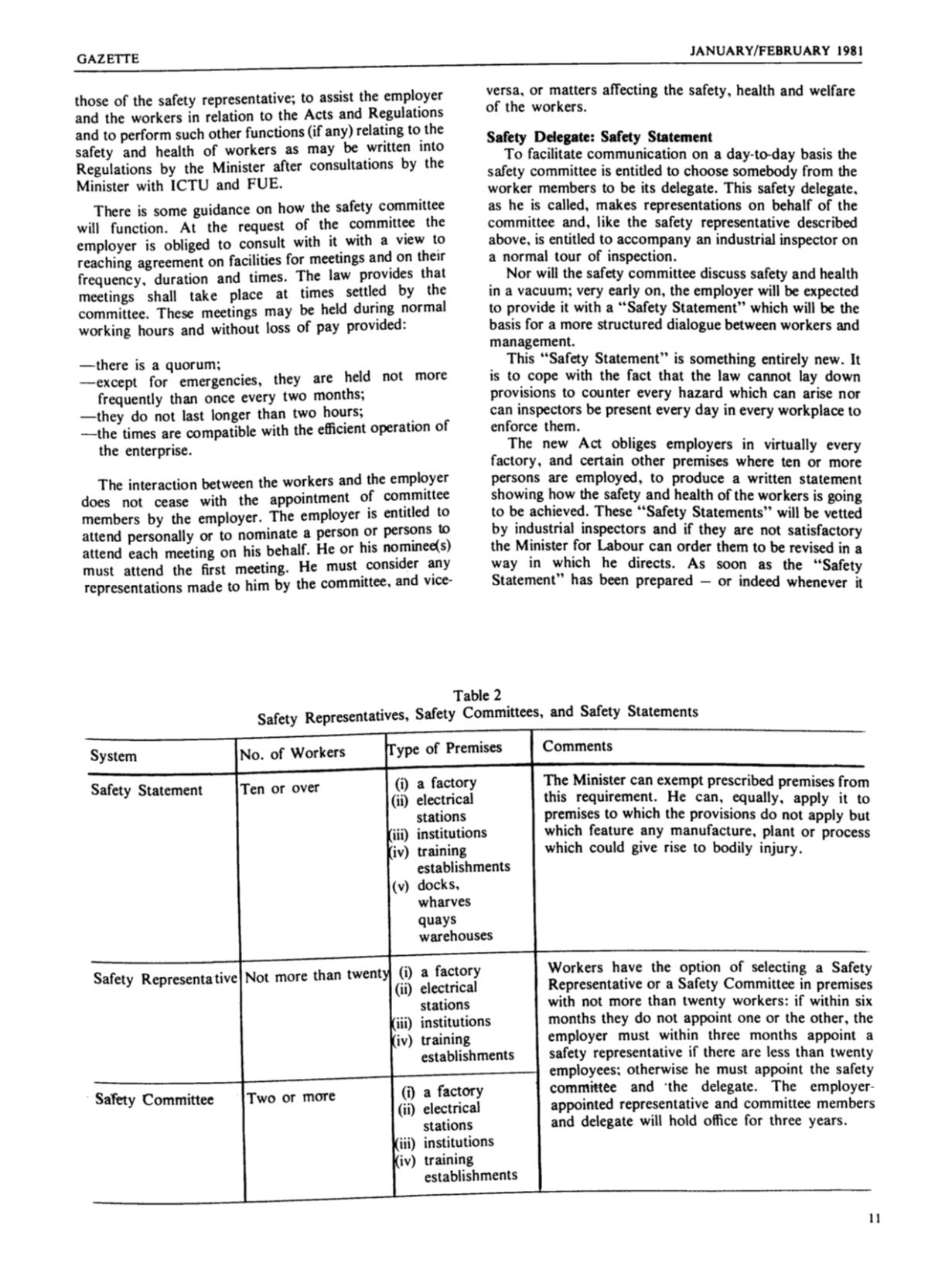

GAZETTE
JANUARY/FEBRUARY 1981
those of the safety representative; to assist the employer
and the workers in relation to the Acts and Regulations
and to perform such other functions (if any) relating to the
safety and health of workers as may be written into
Regulations by the Minister after consultations by the
Minister with ICTU and FUE.
There is some guidance on how the safety committee
will function. At the request of the committee the
employer is obliged to consult with it with a view to
reaching agreement on facilities for meetings and on their
frequency, duration and times. The law provides that
meetings shall take place at times settled by the
committee. These meetings may be held during normal
working hours and without loss of pay provided:
—there is a quorum;
—except for emergencies, they are held not more
frequently than once every two months;
—they do not last longer than two hours;
—the times are compatible with the efficient operation of
the enterprise.
The interaction between the workers and the employer
does not cease with the appointment of committee
members by the employer. The employer is entitled to
attend personally or to nominate a person or persons to
attend each meeting on his behalf. He or his nominee(s)
must attend the first meeting. He must consider any
representations made to him by the committee, and vice-
versa, or matters affecting the safety, health and welfare
of the workers.
Safety Delegate: Safety Statement
To facilitate communication on a day-to-day basis the
safety committee is entitled to choose somebody from the
worker members to be its delegate. This safety delegate,
as he is called, makes representations on behalf of the
committee and, like the safety representative described
above, is entitled to accompany an industrial inspector on
a normal tour of inspection.
Nor will the safety committee discuss safety and health
in a vacuum; very early on, the employer will be expected
to provide it with a "Safety Statement" which will be the
basis for a more structured dialogue between workers and
management.
This "Safety Statement" is something entirely new. It
is to cope with the fact that the law cannot lay down
provisions to counter every hazard which can arise nor
can inspectors be present every day in every workplace to
enforce them.
The new Act obliges employers in virtually every
factory, and certain other premises where ten or more
persons are employed, to produce a written statement
showing how the safety and health of the workers is going
to be achieved. These "Safety Statements" will be vetted
by industrial inspectors and if they are not satisfactory
the Minister for Labour can order them to be revised in a
way in which he directs. As soon as the "Safety
Statement" has been prepared — or indeed whenever it
Table 2
Safety Representatives, Safety Committees, and Safety Statements
System
No. of Workers
rype of Premises
Comments
Safety Statement
Ten or over
(i) a factory
(ii) electrical
stations
;iii) institutions
[iv) training
establishments
(v) docks,
wharves
quays
warehouses
The Minister can exempt prescribed premises from
this requirement. He can, equally, apply it to
premises to which the provisions do not apply but
which feature any manufacture, plant or process
which could give rise to bodily injury.
Safety Representative Not more than twenty (i) a factory
(ii) electrical
stations
(iii) institutions
(iv) training
establishments
Workers have the option of selecting a Safety
Representative or a Safety Committee in premises
with not more than twenty workers: if within six
months they do not appoint one or the other, the
employer must within three months appoint a
safety representative if there are less than twenty
employees; otherwise he must appoint the safety
committee and the delegate. The employer-
appointed representative and committee members
and delegate will hold office for three years.
Safety Committee
Two or more
(i) a factory
(ii) electrical
stations
(iii) institutions
(iv) training
establishments
11
















